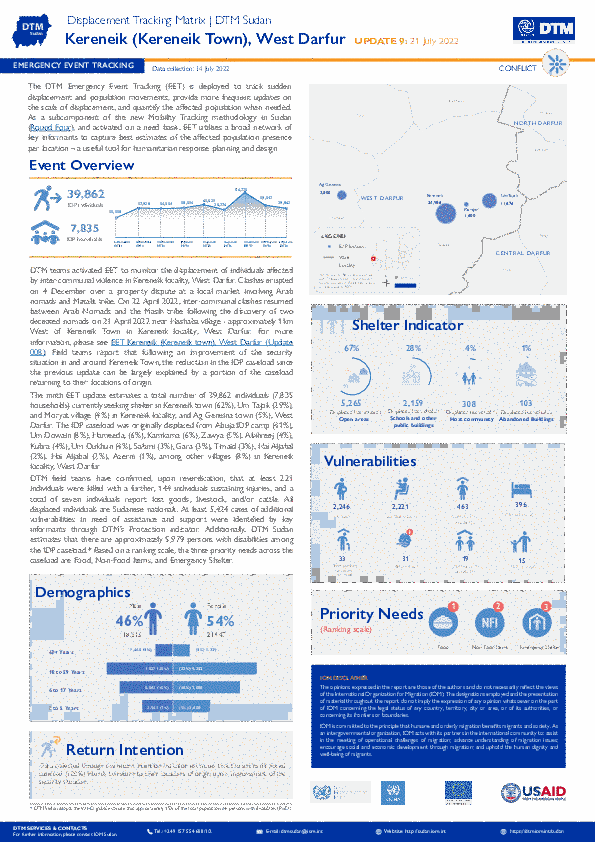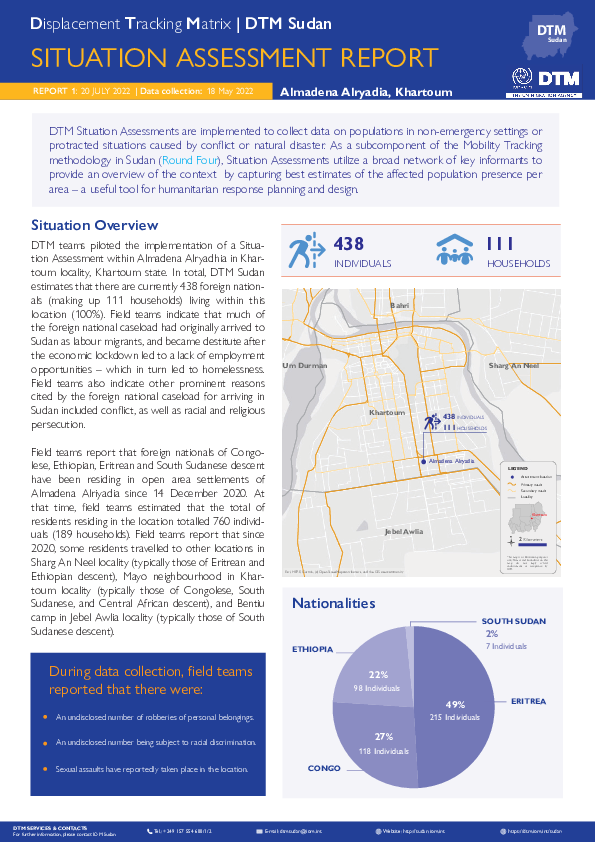-
Countries
-
Data and Analysis
-
Special Focus
-
Crisis Responses

Contact
DTMcovid19@iom.int
Language
English
Location
Global
Period Covered
Jul 11 2022
Jul 18 2022
Activity
- Other
The DTM Global Mobility Restrictions Overview provides updates on international air travel restrictions and conditions for authorized entry. This overview aims to understand how COVID-19 has impacted human mobility, detailing how global and regional trends in air travel measures have evolved since COVID-19 was declared a global pandemic in March 2020. The data presented focuses on the changes in public health-related immigration and border management measures. It provides information intended to support IOM missions and partners in targeted response planning and advocacy for vulnerable populations who may be affected by changes in global mobility.
The early warning and monitoring tool on the situation in the Gulf of Guinea coastal countries (Ghana, Benin, Togo and Côte d'Ivoire), as of 31 May 2022, developed by the GRANIT under the direction of OCHA, IOM and REACH, monitors, based on data and analysis provided by humanitarian and development partners, trends relative to key indicators relating to the situation in the four coastal countries, as of 31 May 2022.
This report examines the evolution, over the first five months of 2022, of the situation in Ghana, Togo, Benin and Côte d'Ivoire in terms of :
- Security incidents
- Types and frequency of violence
- Forced displacement of IDPs and Refugees
- Operational status of international borders
- Food security
- Community dynamics
- Human rights

Contact
DTM Sudan; dtmsudan@iom.int
Language
English
Location
Sudan
Snapshot Date
Jul 14 2022
Activity
- Mobility Tracking
- Event Tracking
The DTM Emergency Event Tracking (EET) is deployed to track sudden displacement and population movements, provide more frequent updates on the scale of displacement, and quantify the affected population when needed. As a subcomponent of the new Mobility Tracking methodology in Sudan (Round Four), and activated on a need basis, EET utilises a broad network of key informants to capture best estimates of the affected population presence per location – a useful tool for humanitarian response planning and design.

Contact
DTM Mali, DTMMali@iom.int
Language
French
Location
Mali
Period Covered
Jun 01 2022
Jun 30 2022
Activity
- Flow Monitoring
Afin de mieux comprendre les mouvements et tendances migratoires, l’OIM, à travers la Matrice de suivi des déplacements (Displacement Tracking Matrix, DTM), met en œuvre l’activité de Suivi des flux de populations (Flow Monitoring, FM).
Le suivi des flux, qui est mis en œuvre en étroite collaboration avec les autorités et des partenaires nationaux et locaux, est composé de deux outils: l’enregistrement des flux (Flow Monitoring Registry, FMR), qui recueille des données clés sur l’ampleur, la provenance, la destination et les modalités des flux de mobilité, et les enquêtes individuelles (Flow Monitoring Survey, FMS), conduites auprès des voyageurs afin d’obtenir des informations sur les profils, parcours migratoires, et intentions des migrants. Le suivi des flux de populations récolte ainsi des données sur les flux et tendances migratoires, les profils des voyageurs et les parcours et intentions des migrants, afin de fournir une meilleure compréhension des mobilités.
Au Mali, la DTM recueille des données au niveau de 7 Points de suivi des flux (Flow Monitoring Points, FMP), répartis dans 6 régions afin d’obtenir une meilleure compréhension de l’ampleur, des tendances, des caractéristiques socio-démographiques et des parcours des flux de voyageurs traversant ces différents points.
Ce rapport présente les données recueillies dans le cadre des activités d’enregistrement des flux durant le mois de juin 2022.

Contact
DTM Mali, DTMMali@iom.int
Language
English
Location
Mali
Period Covered
Jun 01 2022
Jun 30 2022
Activity
- Survey
- Flow Monitoring Survey
- Flow Monitoring
In order to gain a better understanding of mobility flows and trends, the International Organization for Migration (IOM) has implemented the Displacement Tracking Matrix’s Flow Monitoring (FM) tool at key transit points across the region. Flow Monitoring activities are conducted in close cooperation with national and local authorities as well as local partners. The Flow Monitoring tool consists of two main components: the Flow Monitoring Registry (FMR), which captures key data on the volume, origin, destination and mode of travel of mobility flows, and the Flow Monitoring Survey (FMS), individual surveys conducted with travellers to gather detailed information about the profiles, migration experience and intentions of migrants. Through these activities, the Flow Monitoring tool collects data on migration flows and trends, traveller profiles, migration journeys, and intentions of migrants, so as to obtain a better understanding of mobility.
In Mali, DTM conducts Flow Monitoring activities at seven Flow Monitoring Points (FMPs) located across six regions, in order to foster a better understanding of the numbers, trends, profiles, and journeys of migration flows crossing these points.
This reports presents data collected through the Flow Monitoring Registry in June 2022.

Contact
DTM Nigeria, AllUsersInDTMNigeria@iom.int
Language
English
Location
Nigeria
Period Covered
Jun 01 2022
Jun 30 2022
Activity
- Other
- Event Tracking
Similar to other regions in the Sahel, in the state of Adamawa, the population increase and growing numbers of livestock have resulted in the scarcity of arable land and water sources, which are essential to sustain both crop cultivation and cattle herding. The scarcity of land and water has generated farmer-herder conflicts as both communities fight for control of these resources. Encroachment by farmers on grazing land and the blockage of cattle routes have shifted the designated grazing areas and cattle passages. On the other hand, herders regularly destroy crops, pollute water sources and trespass on farms in an attempt to feed their cattle. In addition, growing farmer, herder and cattle population, droughts, environmental degradation, desertification of the Sahel Savannah have further exacerbated scarcity of arable land.
IOM's Displacement Tracking Matrix (DTM), through the Transhumance Tracking Tool (TTT) Early Warning System, collects information on alerts relating to transhumance activities and movements in Adamawa. Data is collected with support from community focal points and key informants. This report presents TTT Early Warning data collected in June 2022 in five LGAs of Adamawa State (Demsa, Girei, Lamurde, Numan and Mayo-Belwa). During this period, 266 alerts were recorded. These alerts consist of 211 events (79%) and 55 mass movements (21%). Events may include situations of conflict, clashes, confrontations, abductions, cattle rustling, and robberies. The largest number of alerts occurred in Demsa LGA (42%), followed by Lamurde LGA (19%) and Numan LGA (18%). When disaggregating the data at ward level, it is to be noted that Kodompti ward in Numan LGA and Demsa ward in Demsa LGA recorded high numbers of alerts in June 2022 (14% and 10% of all event alerts, respectively). It is also important to note that most alerts recorded in Mayo-Belwa LGA were movements alerts. This is mainly because Mayo-Belwa is traversed by the major North-south axis transhumance corridor.
During the period of the assessment, a number of potential risk areas were identified that are prone to conflict and confrontation related to transhumance. As indicated on the map, the majority of these zones are located within the Demsa, Girei, Mayo-Belwa and Fufore LGAs. These areas of potential risk are identified through the monitoring of transhumance movements and the TTT early warning platform.

Contact
DTM Nigeria, AllUsersInDTMNigeria@iom.int
Language
English
Location
Nigeria
Period Covered
Jul 11 2022
Jul 17 2022
Activity
- Mobility Tracking
- Event Tracking
The DTM Emergency Tracking Tool (ETT) is deployed to track and to collect information on large and sudden population movements, provide frequent updates on the scale of displacement and quantify the affected population when needed. As a sub-component of the Mobility Tracking methodology in Nigeria, ETT utilises direct observation and a broad network of key informants to capture best estimates of the affected population per location, enabling targeted humanitarian response planning.
Between 11 and 17 July 2022, a total of 3,975 new arrivals were recorded in Adamawa and Borno States. The new arrivals were recorded at locations in Askira/Uba, Bama, Dikwa, Gwoza, Kala Balge, Monguno and Ngala Local Government Areas (LGAs) of the most conflict-affected state of Borno and in Demsa, Fufore, Gombi, Hong, Maiha, Michika, Mubi South, Song, Yola North and Yola South LGAs of Adamawa State.
ETT assessments identified the following movement triggers: military operations (1,616 individuals or 41%), improved security (959 individuals or 24%), poor living conditions (689 individuals or 17%), family re-unification (314 individuals or 8%), seasonal farming (292 individuals or 7%), access to humanitarian support (85 individuals or 2%) and fear of attack (20 individuals or 1%).

Contact
DTM Sudan; dtmsudan@iom.int
Language
English
Location
Sudan
Snapshot Date
Jul 19 2022
Activity
- Mobility Tracking
- Event Tracking
The DTM Emergency Event Tracking (EET) is deployed to track sudden displacement and population movements, provide more frequent updates on the scale of displacement, and quantify the affected population when needed. As a subcomponent of the new Mobility Tracking methodology in Sudan (Round Four), and activated on a need basis, EET utilises a broad network of key informants to capture best estimates of the affected population presence per location – a useful tool for humanitarian response planning and design.

Contact
DTM Sudan; dtmsudan@iom.int
Language
English
Location
Sudan
Snapshot Date
May 18 2022
Activity
- Other
DTM Situation Assessments are implemented to collect data on populations in non-emergency settings or protracted situations caused by conflict or natural disaster. As a subcomponent of the Mobility Tracking methodology in Sudan (Round Four), Situation Assessments utilize a broad network of key informants to provide an overview of the context by capturing best estimates of the affected population presence per area – a useful tool for humanitarian response planning and design.
